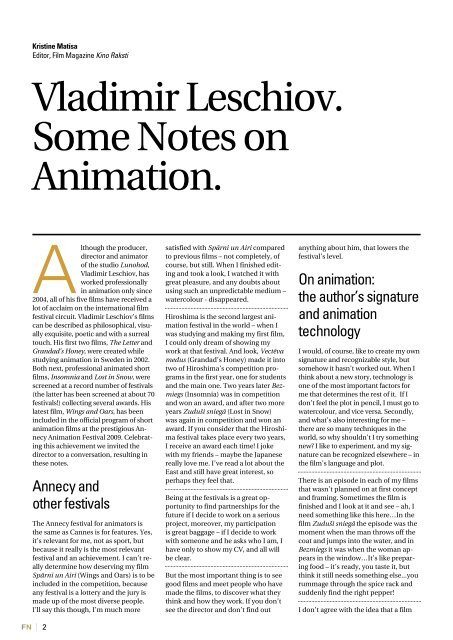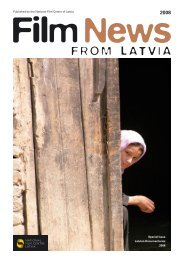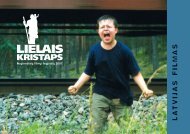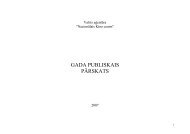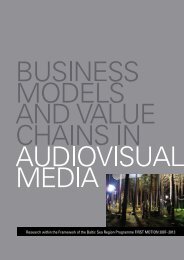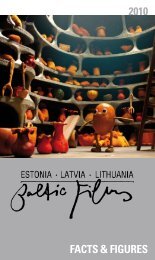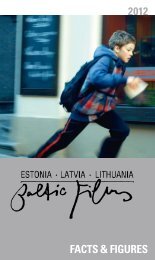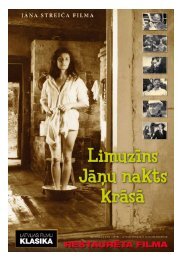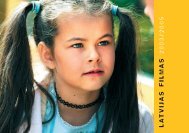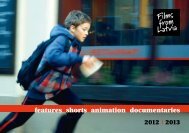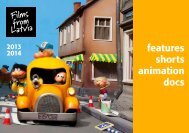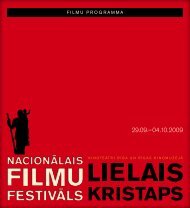Latvian Animation - NacionÄlais Kino centrs
Latvian Animation - NacionÄlais Kino centrs
Latvian Animation - NacionÄlais Kino centrs
You also want an ePaper? Increase the reach of your titles
YUMPU automatically turns print PDFs into web optimized ePapers that Google loves.
Kristīne Matīsa<br />
Editor, Film Magazine <strong>Kino</strong> Raksti<br />
Vladimir Leschiov.<br />
Some Notes on<br />
<strong>Animation</strong>.<br />
Although the producer,<br />
director and animator<br />
of the studio Lunohod,<br />
Vladimir Leschiov, has<br />
worked professionally<br />
in animation only since<br />
2004, all of his five films have received a<br />
lot of acclaim on the international film<br />
festival circuit. Vladimir Leschiov’s films<br />
can be described as philosophical, visually<br />
exquisite, poetic and with a surreal<br />
touch. His first two films, The Letter and<br />
Grandad’s Honey, were created while<br />
studying animation in Sweden in 2002.<br />
Both next, professional animated short<br />
films, Insomnia and Lost in Snow, were<br />
screened at a record number of festivals<br />
(the latter has been screened at about 70<br />
festivals!) collecting several awards. His<br />
latest film, Wings and Oars, has been<br />
included in the official program of short<br />
animation films at the prestigious Annecy<br />
<strong>Animation</strong> Festival 2009. Celebrating<br />
this achievement we invited the<br />
director to a conversation, resulting in<br />
these notes.<br />
Annecy and<br />
other festivals<br />
The Annecy festival for animators is<br />
the same as Cannes is for features. Yes,<br />
it’s relevant for me, not as sport, but<br />
because it really is the most relevant<br />
festival and an achievement. I can’t really<br />
determine how deserving my film<br />
Spārni un Airi (Wings and Oars) is to be<br />
included in the competition, because<br />
any festival is a lottery and the jury is<br />
made up of the most diverse people.<br />
I’ll say this though, I’m much more<br />
satisfied with Spārni un Airi compared<br />
to previous films – not completely, of<br />
course, but still. When I finished editing<br />
and took a look, I watched it with<br />
great pleasure, and any doubts about<br />
using such an unpredictable medium –<br />
watercolour - disappeared.<br />
Hiroshima is the second largest animation<br />
festival in the world – when I<br />
was studying and making my first film,<br />
I could only dream of showing my<br />
work at that festival. And look, Vectēva<br />
medus (Grandad’s Honey) made it into<br />
two of Hiroshima’s competition programs<br />
in the first year, one for students<br />
and the main one. Two years later Bezmiegs<br />
(Insomnia) was in competition<br />
and won an award, and after two more<br />
years Zuduši sniegā (Lost in Snow)<br />
was again in competition and won an<br />
award. If you consider that the Hiroshima<br />
festival takes place every two years,<br />
I receive an award each time! I joke<br />
with my friends – maybe the Japanese<br />
really love me. I’ve read a lot about the<br />
East and still have great interest, so<br />
perhaps they feel that.<br />
Being at the festivals is a great opportunity<br />
to find partnerships for the<br />
future if I decide to work on a serious<br />
project, moreover, my participation<br />
is great baggage – if I decide to work<br />
with someone and he asks who I am, I<br />
have only to show my CV, and all will<br />
be clear.<br />
But the most important thing is to see<br />
good films and meet people who have<br />
made the films, to discover what they<br />
think and how they work. If you don’t<br />
see the director and don’t find out<br />
anything about him, that lowers the<br />
festival’s level.<br />
On animation:<br />
the author’s signature<br />
and animation<br />
technology<br />
I would, of course, like to create my own<br />
signature and recognizable style, but<br />
somehow it hasn’t worked out. When I<br />
think about a new story, technology is<br />
one of the most important factors for<br />
me that determines the rest of it. If I<br />
don’t feel the plot in pencil, I must go to<br />
watercolour, and vice versa. Secondly,<br />
and what’s also interesting for me –<br />
there are so many techniques in the<br />
world, so why shouldn’t I try something<br />
new? I like to experiment, and my signature<br />
can be recognized elsewhere – in<br />
the film’s language and plot.<br />
There is an episode in each of my films<br />
that wasn’t planned on at first concept<br />
and framing. Sometimes the film is<br />
finished and I look at it and see – ah, I<br />
need something like this here…In the<br />
film Zuduši sniegā the episode was the<br />
moment when the man throws off the<br />
coat and jumps into the water, and in<br />
Bezmiegs it was when the woman appears<br />
in the window…It’s like preparing<br />
food – it’s ready, you taste it, but<br />
think it still needs something else...you<br />
rummage through the spice rack and<br />
suddenly find the right pepper!<br />
I don’t agree with the idea that a film<br />
needs only one main character – every<br />
good film has to have at least one<br />
character that appears, disappears, and<br />
we don’t know anything about him -<br />
it’s Fellini’s finest trick. If you’re filming<br />
on the street, then the usual way is to<br />
seal the whole block off with police<br />
tape, have actors in all the windows,<br />
and lock the doors so that there are no<br />
mishaps – we’re filming! But in a Fellini<br />
film, suddenly, calmly, in the middle<br />
of a scene, a second storey window<br />
flies open and a rotund Italian woman<br />
shakes out her enormous drawers,<br />
fastens them to the laundry line and<br />
shuts the window. And that lends<br />
credibility to the rest of what happens<br />
in the scene, that’s Fellini’s realism.<br />
<strong>Animation</strong> brings everything to life<br />
– old photographs, interviews, drawings…but<br />
it isn’t anything radical – it’s<br />
simply one of the ways it can be done.<br />
And documentary animation is actually<br />
an even easier method – if you have,<br />
for example, old albums with photos<br />
or drawings, you already have a readymade<br />
film setting and a world that<br />
doesn’t have to be constructed from<br />
scratch, just brought to life. But when<br />
you start from zero with a storyboard<br />
and frames, you have to depict each<br />
detail of a completely new world that<br />
Wings and Oars<br />
hasn’t previously existed, only in your<br />
fantasy, and that is a very lengthy and<br />
serious process.<br />
I don’t see how 3D animation can develop.<br />
You can experiment with other<br />
animation methods and figure out new<br />
ways, but with this it isn’t possible –<br />
your new animation medium is your<br />
newest super computer, and you have<br />
to buy an even newer and better one<br />
next year. That’s simply the development<br />
of equipment, not animation.<br />
Okay, you’ll have even more perfect<br />
lighting and precise movement, and<br />
finally we won’t be able to tell the difference<br />
between 3D animation and<br />
reality – but what’s the point?! A few<br />
years ago the Americans said – it’s going<br />
to be great, soon we won’t have to<br />
pay actors huge salaries, we can make<br />
anything in 3D. But who will want to<br />
watch something synthetic with no life?<br />
Schools of Art<br />
and Life<br />
At this point I’m more or less trying to<br />
forget everything I learned at the Jānis<br />
Rozentāls Art School, because sometimes<br />
when I draw something freely as<br />
I feel it, the knowledge slowly starts to<br />
creep in, and it ends up being too correct.<br />
I feel an image and I know how<br />
it should move, but knowledge of correct<br />
proportions messes about in my<br />
head… I can animate any image, even<br />
those that don’t exist in reality; I know<br />
what the internal skeleton is or should<br />
be. But sometimes I need to work freely,<br />
and it’s not easy.<br />
When I finished school, my teacher<br />
said that I would definitely get into the<br />
graphics department at the Art Academy<br />
of Latvia. After the entrance exams<br />
– never in my life have I’ve been as sure<br />
of something as when I went to see my<br />
results. I was sure I was in, but when<br />
I saw the results…at first I thought it<br />
was a mistake, and at that time it only<br />
meant one thing – off to the army. I<br />
went to the enlistment office and the<br />
officer was gleeful – so Leschiov, didn’t<br />
get in? Here you go – Severnij flot in<br />
Murmansk…I didn’t serve the whole<br />
three years though, as it was the end of<br />
the 80s and they let us go home after<br />
two. I returned, no one needed me, and<br />
I had forgotten how to draw…I worked<br />
in advertising for a time and made the<br />
first 3D graphics even though I didn’t<br />
know anything about computers. And<br />
so I worked and worked, going from<br />
FN | 2<br />
2<br />
FN | 3


